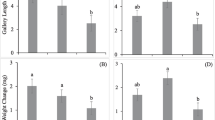Abstract
The response of the European elm bark beetle,Scolytus multistriatus, to host bacterial isolates was studied qualitatively under field conditions. Initial experiments indicated that such isolates were attractive to in-flight beetles. These isolates, identified asBacillus subtilis (five strains),B. pumilus, andEnterobacter cloacae, were grown on nutrient agar in glass vials and attached to sticky traps in elm woods. Although beetles were caught on the bacterial isolate-baited traps, the catches were variable, inconsistent, and often contradictory from one experiment to another. High numbers ofS. multistriatus were caught on traps baited with three strains ofB. subtilis, but in addition to thesubtilis strains, there were also aerial contaminants in the treatments, namelyE. aerogenes, Corynebacterium sp., andFlavobacterium sp. Also, relatively high catches were recorded on nutrient agar controls. When elm wood-bark plugs, sterilized (by gamma irradiation) and unsterilized, were placed in vials with the host bacterial isolates, the presence or absence of fresh elm, gamma irradiated or not, had no noticeable effect on beetle attractancy.
Similar content being viewed by others
References
Brand, J.M., Bracke, J.W., Markovetz, A.J., Wood, D.L., andBrowne, L.E. 1975. Production of verbenol pheromone by a bacterium isolated from bark beetles.Nature 254:136–137.
Callaham, R.Z. 1952. Host selection and host susceptibility in the western pine beetle-ponderosa pine complex. Pacific Southwest For. Range Exp. Sta. Unpubl, Rep. (Cited by Miller, J.M., and Keen, F.P. 1960. Biology and control of the western pine beetle. U.S. Dept. Agr. Misc. Publ. No. 800.)
Chararas, C. 1977. Physiologie des insectes. L'action synergique des constituants glucidiques et des constituants terpeniques dans le processus d'attraction secondaire et le mecanisme de l'elaboration des pheromones chez le Scolytidae parasites des coniferes.C.R. Acad. Sci. Hebd. Seances 284:1545–1548.
French, J.R.J. 1972. Biological interrelationships between the ambrosia beetleXyteborus dispar and its symbiotic fungusAmbrosiella hartigii, Ph.D. dissertation. Oregon State University, Corvallis.
French, J.R.J., Robinson, P.J., andMinko, G. 1982. Gamma irradiating elm billets reduces their attractancy to the smaller elm bark beetle,Scolytus multistriatus (Marsham).Z. Angew Entomol. 94:175–179.
Gardiner, L.M. 1981. Seasonal activity of the native elm bark beetle,Hylurgopinus rufipes, in central Ontario (Coleoptera: Scolytidae).Can. Entomol. 113:341–348.
Graham, K. 1968. Anaerobic induction of primary chemical attractancy for ambrosia beetles.Can. J. Zool. 46:905–908.
Greaves, H., andSavory, J.G. (1965). Studies of the microfungi attacking preservative-treated timber, with particular reference of methods for their isolation.J. Inst. Wood Sci. 15:45–50.
Heikkenen, H.J. 1977. Southern pine beetle: A hypothesis regarding its primary attractant.J. For. 75:412–413.
Hynum, B.G., andBerryman, A.A. 1980.Dendroctonus ponderosae (Coleoptera: Scolytidae): Pre-aggregation landing and gallery initiation on lodgepole pine.Can. Entomol. 112:185–191.
Knutson, D.M. 1970. A method for sampling yeasts and bacteria in sound wood. Pacific Northwest For. Range Exp. Sta. Res. Note PNW-128.
Lanier, G.N., Silverstein, R.M., andPeacock, J.W. 1976. Attractant pheromone of the European elm bark beetle (Scolytus multistriatus): Isolation, identification, synthesis, and utilization studies, pp. 149–175,in J.F. Anderson and H.K. Kaya (eds.). Perspectives in Forest Entomology. Academic Press, New York.
Meyer, H.J., andNorris, D.M. 1967. Behavioral responses byScolytus multistriatus (Coleoptera: Scolytidae) to host (Ulmus) and beetle-associated chemotactic stimuli.Ann. Entomol. Soc. Am. 60:642–647.
Moeck, H.A., Wood, D.L., andLindahl, K.Q., Jr. 1981. Host selection behavior of bark beetles (Coleoptera: Scolytidae) attackingPinus ponderosa, with special emphasis on the western pine beetle,Dendroctonus brevicomis.J. Chem. Ecol. 7:49–83.
Peacock, J.W. 1975. Research on chemical and biological control of elm bark beetles, pp. 18–49,in D.A. Burdekin and H.M. Heybroek (eds.). Dutch Elm Disease. Proc. IUFRO Conf. Minneapolis-St. Paul, Minn.
Peacock, J.W., Lincoln, A.C., Simeone, J.B., andSilverstein, R.M. 1971. Attraction ofScolytus multistriatus (Coleoptera: Scolytidae) to a virgin-female-produced pheromone in the field.Ann. Entomol. Soc. Am. 64:1143–1149.
Pearce, G.T., Gore, W.E., Silverstein, R.M., Peacock, J.W., Cuthbert, R.A., Lanier, G.N., andSimeone, J.B., 1975. Chemical attractants for the smaller European elm bark beetleScoyltus multistriatus (Coleoptera: Scolytidae).J. Chem. Ecol. 1:115–124.
Person, H.L. 1931. Theory in explanation of the selection of certain trees by the western pine beetle.J. For. 29:696–699.
Renwick, J.A.A., andVité, J.P. 1970. Systems of chemical communication inDendroctonus. Contrib.Boyce Thompson Inst. 24:283–292.
Tudroszen, N.J., Kelly, D.P., andMillis, N.F. 1977. α-Pinene metabolism byPseudomonas putida.Biochem. J. 168:315–318.
Vité, J.P., andPitman, G.B. 1968. Bark beetle aggregation: Effects of feeding on the release of pheromones inDendroctonus andIps.Nature 218:169–170.
von Keyserlingk, H. 1982. The response ofScolytus scolytus to volatile host plant stimuli, pp. 399–400,in J.H. Visser and A.K. Minks (eds.). Insect-Plant Relationships. Proc. 5th Int. Symp. Wageningen, Netherlands, Pudoc.
White, R.A., Jr., Agosin, M., Franklin, R.T., andWebb, J.W. 1980. Bark beetle pheromones: Evidence for physiological synthesis mechanisms and their ecological implications.Z. Angew. Entomol. 90:255–274.
Wollerman, E.H. 1979. Attraction of European elm bark beetles,Scolytus multistriatus, to pheromone-baited traps.J. Chem. Ecol. 5:781–793.
Wood, D.L. 1972. Selection and colonization of ponderosa pine by bark beetles, pp. 101–117,in H.F. van Emden (ed.). Insect/Plant Relationships. Symp. R. Entomol. Soc. London No. 6., Blackwell, London.
Author information
Authors and Affiliations
Additional information
Coleoptera: Scolytidae.
Rights and permissions
About this article
Cite this article
French, J.R.J., Robinson, P.J., Minko, G. et al. Response of the european elm bark beetle,Scolytus multistriatus, to host bacterial isolates. J Chem Ecol 10, 1133–1149 (1984). https://doi.org/10.1007/BF00987519
Received:
Revised:
Issue Date:
DOI: https://doi.org/10.1007/BF00987519




